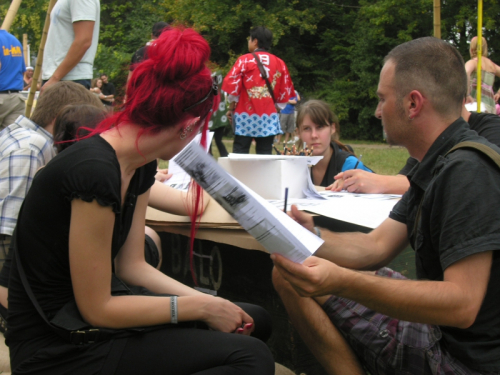László Moholy-Nagy (1895-1946) is a world-famous figure of twentieth-century avant-garde art. As a most versatile artist he had a radically experimental practice in the field of painting, sculpture, photography and film as well as commercial and industrial design and scenography. His visual art together with his theoretical and educational work, his photographs, films and photograms - now synonymous with his name - were of such significance that they have transformed our thinking about art. In the series of Hungarian artists who accomplished world fame - Robert Capa, Martin Munkácsi, György Kepes - the Ludwig Museum - Museum of Contemporary Art now presents the work of László Moholy-Nagy in an impressive exhibition.
Moholy-Nagy began his creative career at twenty years old in the first half of the twentieth century in Lajos Kassák’s activist circle as one of Hungary’s youngest avant-garde artists. In 1919 he left for Vienna then Berlin, where he came under the influence of Dadaism and Constructivism, which he later developed further independently. On the invitation of director Walter Gropius in 1923, he became a teacher at the Weimar Bauhaus. As well as exploring painting, leading the Metal Workshop, writing and editing books and applying new typographies, at this most progressive art school of the time promoting the unity of life, art and science Moholy-Nagy also turned towards photography and film.
The central organising principle in Moholy-Nagy’s diverse activities was light: light defined his paintings, sculptures, photoplastics, photograms, photographs, typography and theatre sets. He did not regard photography as a tool for the perfect imaging of reality; rather, it was his conviction that the camera offered new possibilities for modern people, and finally liberates art from the obligation to depict, to copy reality. The years at the Bauhaus proved to be an experience that defined his entire life. He settled in Chicago in 1937, where he founded the ‘New Bauhaus’ and soon the Institute of Design and worked until the end of his life as an experimental, innovative artist, theorist and teacher. László Moholy-Nagy regarded art as a non-hierarchical, widely accessible and cultivatable activity that embraced the whole of life, and he firmly believed in the educational significance of it.
The exhibition at the Ludwig Museum presents his diverse life achievement from 1922, with Moholy-Nagy’s photography, films, and works ‘made with light’ in central focus. One of the most exciting parts of the exhibition is the compilation of all Moholy-Nagy’s films, shown together here for the first time and according to the artist’s original conception. This ambitious and large-scale show of Moholy-Nagy’s oeuvre presents more than 200 pieces and documents from over twenty museums around the world as well as private collections. After Madrid, Berlin and The Hague, the exhibition arriving in Budapest - due to the contribution of two internationally-renowned Hungarian art historians, experts of Moholy-Nagy, Krisztina Passuth and Éva Bajkay - is complemented by photographs and publications from Hungarian collections. Thanks to László Moholy-Nagy’s family, valuable documents that have not been seen in any of the earlier locations also have been added to the exhibition.
The exhibition is curated by Oliva Maria Rubio. Coordinators: Kata Oltai, Victoria del Val.
The exhibition has been realised in partnership between Ludwig Museum-Museum of Contemporary Art, Circulo de Bellas Artes, Madrid, Martin-Gropius-Bau, Berlin, Gemeentemuseum Den Haag and La Fábrica.
The exhibition takes place within the programme of the Hungarian EU presidency, and is supported by Hungarofest.


















Related contents

Family Matinee: The world as you have never seen it before 24. September, 2011, 00:00–00:00
Creative session for children in connection with the László Moholy-Nagy. The Art of Light exhibition, with photogram making and much more.
No booking required.
Admission with a 600 HUF Programme ticket.

Family Matinee: The world as you have never seen it before 17. September, 2011, 00:00–00:00
Creative session for children in connection with the László Moholy-Nagy. The Art of Light exhibition, with photogram making and much more.
No booking required.
Admission with a 600 HUF Programme ticket.

Integrated Family Matinee: The world as you have never seen it before 10. September, 2011, 00:00–00:00
Integrated creative session for children, including those with special needs, in connection with the László Moholy-Nagy. The Art of Light exhibition, with photogram making and much more.

Sziget Festival 2011 14. August, 2011, 00:00–00:00
Let`s meet at the biggest Hungarian summer festival!
The Ludwig Museum - Museum of Contemporary Art and the Museum of Ethnography presents:
Unlimited Atelier

Sziget Festival 2011 13. August, 2011, 00:00–00:00
Let`s meet at the biggest Hungarian summer festival!
The Ludwig Museum - Museum of Contemporary Art and the Museum of Ethnography presents:
Unlimited Atelier

Sziget Festival 2011 12. August, 2011, 00:00–00:00
Let`s meet at the biggest Hungarian summer festival!
The Ludwig Museum - Museum of Contemporary Art and the Museum of Ethnography presents:
Unlimited Atelier

Sziget Festival 2011 11. August, 2011, 00:00–00:00
Let`s meet at the biggest Hungarian summer festival!
The Ludwig Museum - Museum of Contemporary Art and the Museum of Ethnography presents:
Unlimited Atelier

Sziget Festival 2011 10. August, 2011, 00:00–00:00
Let`s meet at the biggest Hungarian summer festival!
The Ludwig Museum - Museum of Contemporary Art and the Museum of Ethnography presents:
Unlimited Atelier

Friends of the Ludwig Museum: Exclusive Guided Tour 7. July, 2011, 00:00–00:00
The Friends of the Ludwig Museum cordially invites you to its upcoming event:
Exclusive guided tour at the László Moholy-Nagy. The Art of Light exhibition with Nóra Winkler.
On Thursday 7 July 2011 at the 2nd floor exhibition space.

Guided Tours in English and Hungarian: László Moholy-Nagy 1. July, 2011, 00:00–00:00
Regular Guided Tours at the László Moholy-Nagy. The Art of Light Exhibition
Tuesday to Sunday
• IN ENGLISH: 14.00 and 16.00
• IN HUNGARIAN: 18.00
Programme ticket: 600 HUF and a valid exhibition ticket
No booking required.
